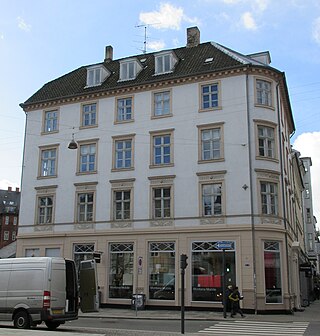
Bredgade 24 is a listed building located at the corner of Bredgade and Sankt Annæ Plads in central Copenhagen, Denmark. The building was listed on the Danish registry of protected buildings in 1987. Notable former residents include painter and photographer Niels Christian Hansen.

Niels Hemmingsens Gade 32 is a historic building in the Old Town of Copenhagen, Denmark. It was built in the first half of the 1740s. A brewery was for more than one hundred years operated in a rear wing. Brødrene Cloëtta, one of Denmark's leading chocolate manufacturers of its day, was based in the building from 1865 until 1901. The three-winged building complex was listed on the Danish registry of protected buildings and places in 1981. A gilded Neptune figure is seen above the gateway and the keystone features the names of the first owners. Notable former residents include the naval officers Poul de Løvenørn and Peter Nicolay Skibsted, the businessman Conrad Hauser and the linguist Rasmus Rask.

Nybroegade 22/Magstræde 9 is a complex of historic buildings overlooking Slotsholmen Canal and Christiansborg in central Copenhagen, Denmark. It consists of a five-storey apartment building from the 1850s in Nybrogade and a four-storey building from 1755 on the other side of the block in Magstræde, separated from each other by a small, cobbled courtyard. The entire complex was listed on the Danish registry of protected buildings and places in 1945.

Gammel Strand 36 is a Neoclassical property overlooking Slotsholmen Canal in the Olt Town of Copenhagen, Denmark. The building was listed in the Danish registry of protected buildings and places in 1945. Notable former residents include the composer Franz Joseph Glæser.

Lille Strandstræde 18 is a Neoclassical property situated off Sankt Annæ Plads in central Copenhagen, Denmark. It was listed in the Danish registry of protected buildings and places in 1950.

Højbro Plads 15 is a Neoclassical property situated on Højbro Plads in central Copenhagen, Denmark. The building was like most of the other buildings in the area constructed as part of the rebuilding of the city following the Copenhagen Fire of 1795. It was listed in the Danish registry of protected buildings and places in 1950.
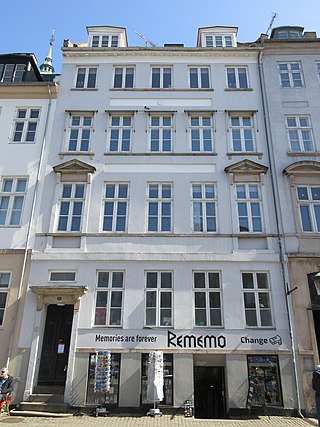
Højbro Plads 17 is a Neoclassical property situated on the east side of Højbro Plads in central Copenhagen, Denmark. The building was like most of the other buildings in the area constructed as part of the rebuilding of the city following the Copenhagen Fire of 1795. It was listed in the Danish registry of protected buildings and places in 1924.
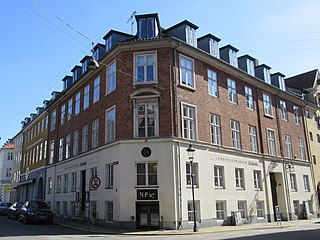
Nikolaj Plads 27 is a Neoclassical property situated at the corner of Nikolaj Plads and Admiralgade in central Copenhagen, Denmark. It was like most of the other buildings in the area constructed as part of the rebuilding of the city following the Copenhagen Fire of 1795. It was listed in the Danish registry of protected buildings and places es in 1945.
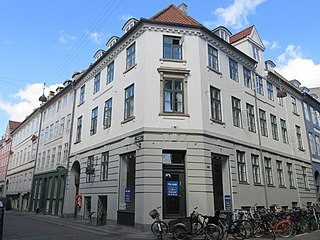
Kompagnistræde 10 is a Neoclassical property situated at the corner of Kompagnistræde and Badstuestræde in the Old Town of Copenhagen, Denmark. A bakery was operated on the site from at least the 17th century until the late 19th century. Like many of the other buildings in the area, the current building was constructed as part of the rebuilding of the city following the Copenhagen Fire of 1795. A gilded relief of a kringle above a door in the courtyard bears testament to the former use of the property. The entire complex was listed in the Danish registry of protected buildings and places in 1949. Former residents include orientalist Carl Theodor Johannsen and composer Christian Julius Hansen.

Rådhusstræde 9 is an 18th-century property situated at the corner of Rådhusstræde and Kompagnistræde in the Old Town of Copenhagen, Denmark. The building was listed in the Danish registry of protected buildings and places in 1945. Former residents include the chemist Peter Ascanius and the marine painter Christian Eckardt. Galatheakroen, a bar decorated with exotica brought home from the 2nd Galathea Expedition, was opened in the ground floor by a former expedition member in 1958.
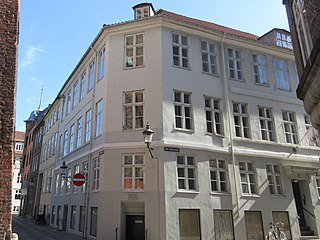
Lille Kirkestræde 1/Nikolaj Plads 28 is a Neoclassical corner building situated in front of the former St. Nicolas' Church, now Kunsthallen Nikolaj, in central Copenhagen, Denmark. It was listed in 1945. The building was like most of the buildings in the area constructed following the Copenhagen Fire of 1795. It was listed in the Danish registry of protected buildings and places in 1945.

Sankt Annæ Plads 6/Lille Strandstræde 24 is an 18th-century property situated at the corner of Sankt Annæ Plads and Lille Strandstræde, across the street from the Garrison Church, in central Copenhagen, Denmark. With its low height and a principal facade that does not face Sankt Annæ Plads, it stands out from the other buildings on the square, bearing testament to a time when the city was lower and Frederiksstaden had only just started to develop. It was listed in the Danish registry of protected buildings and places in 1950 and is now owned by Karberghus.
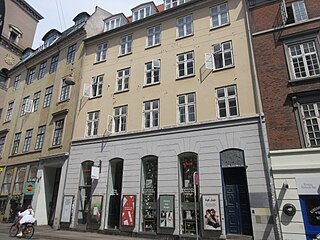
Nørregade 4 is an early 19th-century property situated in Nørregade, between Frue Plads and Gammeltorv, in the Old Town of Copenhagen, Denmark. The building was listed in the Danish registry of protected buildings and places in 1945.

Rosenborggade 19 is an 18th-century property situated at the corner of Rosenborggade and Gothersgade, opposite Rosenborg Castle and next to the Reformed Church, in the Old Town of Copenhagen, Denmark. It was expanded with a detached two-storey building at Gothersgade 113 in 1825. The two buildings were both listed in the Danish registry of protected buildings and places in 1987.

Torvegade 28/Wildersgade 26 is an 18th-century building complex situated on the corner of Torvegade and Wildersgade in the Christianshavn neighborhood of central Copenhagen, Denmark. It consists of a four-storey corner building and an adjacent three-storey former warehouse in Wildersgade. The two buildings were both heightened with one storey in 1852. The property was for almost two hundred years—from 1727 until 1917—owned by bakers. Their bakery was located in a side wing. A sandstone tablet with a relief of a crowned kringle and a cartouche with the initials of a former owner and the year ""Anno 1770" can still be seen above the shop entrance in Torvegade. The entire complex was listed in the Danish registry of protected buildings and places in 1982.

Stiftprovsteboligen, situated at the corner of Fiolstræde and Store Kannikestræde, opposite the Church of Our Lady, is the official residence of the provost (domprovst) of the Provostry of Our Lady–Vesterbro. The domprovst of the Provostry of Our Lady–Vesterbro is the most senior of the provosts of the Diocese of Copenhagen. The administrative office of the provostry is in the basement of the building. The Neoclassical building from 1840–41 was listed in the Danish registry of protected buildings and places in 1939. A plaque on the garden wall towards Fiolstræde commemorates that Ludvig Holberg resided in an earlier building on the site from June 1740 until his death in January 1754.

Hauser Plads 12 is a Neoclassical property situated on the south side of Hauser Plads in the Old Town of Copenhagen, Denmark. It was listed in the Danish registry of protected buildings and places in 1945. Notable former residents include the actor Jørgen Christian Hansen and the film director Carl Theodor Dreyer.

Hauser Plads 24/Pbenrå 23 is an 18th-century building complex occupying an irregular corner site between the square Hauser Plads and the street Åbenrå, north of a short unnamed street section linking the square with the street, in the Old Town of Copenhagen, Denmark. It is the only building on the square that dates from the time before the British bombardment in 1807 and the subsequent creation of the square. It was listed in the Danish registry of protected buildings and places in 1945. Niels Frommelt operated an underground printing workshop in the building during the German occupation of Denmark in World War II.

Hauser Plads 16 is an 11-bays-wide, mid 19th-century building situated on the east side of Hauser Plads in the Old Town of Copenhagen, Denmark. The building was listed in the Danish registry of protected buildings and places in 1945. Notable former residents include writer and educator Harald Valdemar Rasmussen (1821–1891) and painter Julius Exner. Restaurant Schønnemann, one of Copenhagen's oldest traditional lunch restaurants, known for its smørrebrød and large selection of Snaps, has been located in the basement since 1901.

Rådhusstræde 7 is a Neoclassical building situated at the corner of Rådhusstræde and Kompagnistræde in the Old Town of Copenhagen, Denmark. The building was like most of the other buildings in the street constructed as part of the rebuilding of the city following the Copenhagen Fire of 1795. It was listed in the Danish registry of protected buildings and places in 1918. The scope of the heritage listing was expanded in 1979. Notable former residents include the civil servant and naturalist Carl Gottlob Rafn and professor of philosophy Frederik Christian Sibbern.

























